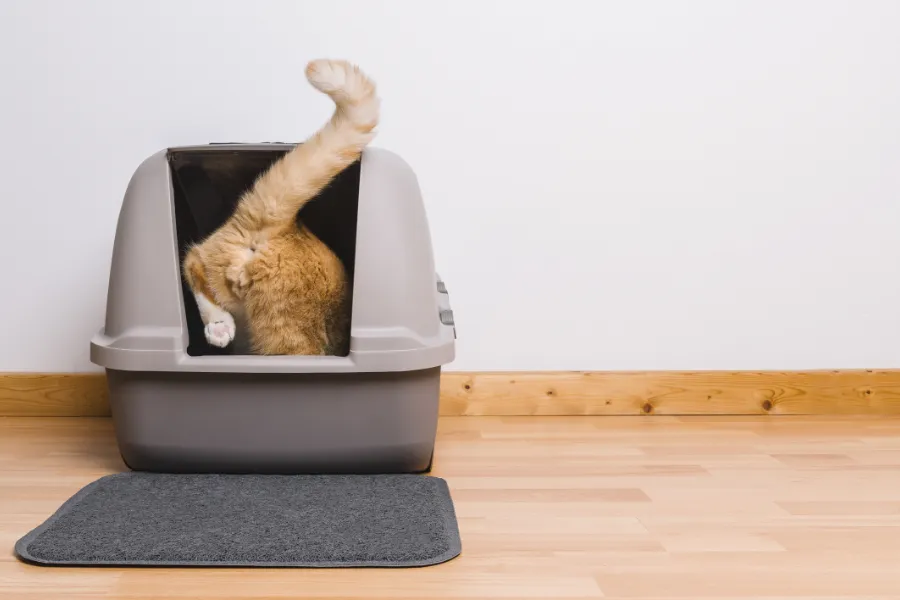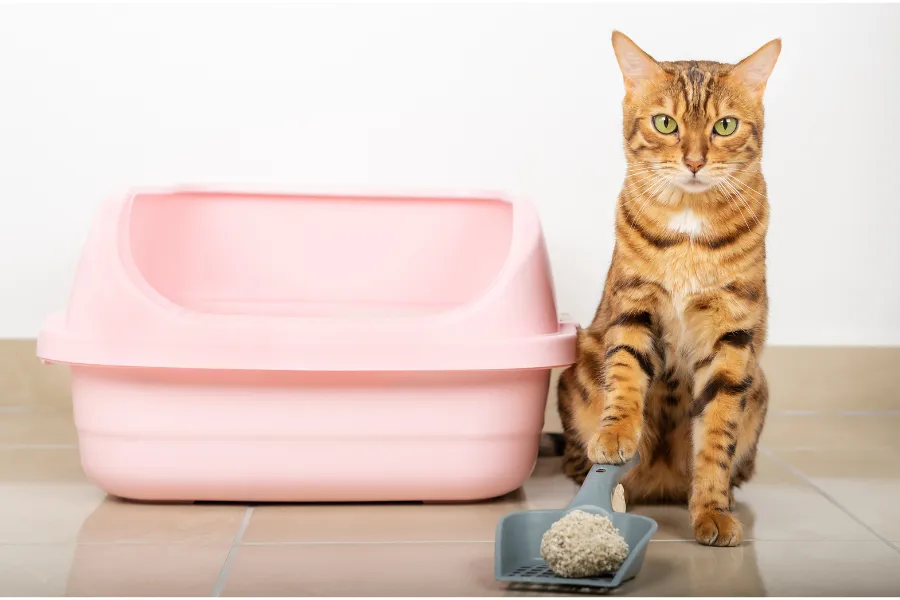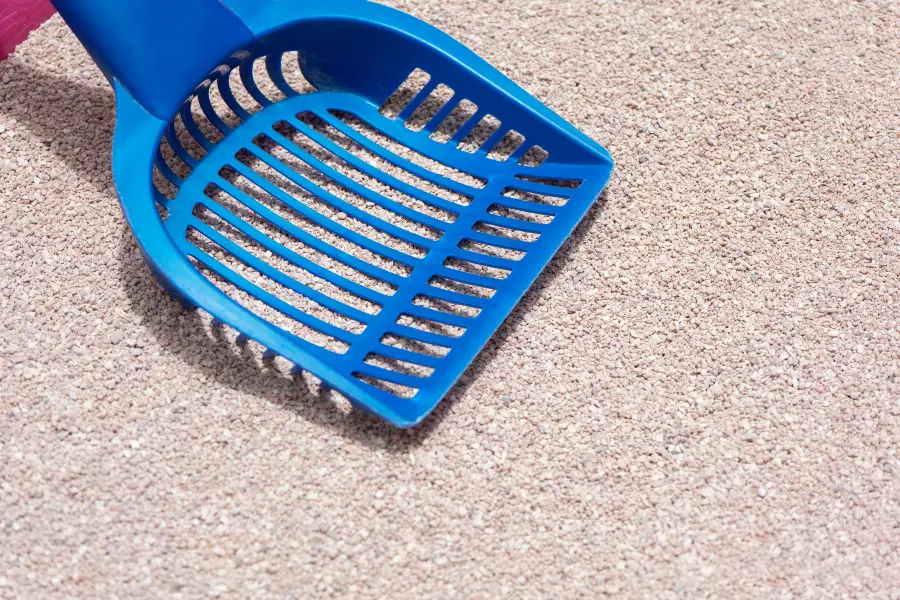Have you got a cat and a litter box problem? You’re not the only one! It’s a common bother for kitty owners.
In this guide, we’ll gab about the different reasons for litter box troubles and give solutions to make it better for your cats and you.
Common litter box problems in cats
Litter box issues cause cats to be surrendered to animal shelters. To address this, cat owners need help. This guide has strategies for the most common litter box issues.
- Medical Issues: Medical causes such as bladder infections, inflammatory bowel disease, constipation, and kidney failure can make cats pee outside the box. Take them to the vet for an exam.
- Behavioral Problems: Stress can lead cats to miss the litter box. Providing multiple litter boxes in the house can help prevent this. Identify sources of stress and create a calm environment.
- Environmental Changes: Cats may not like changes like different litter or furniture. Provide multiple litter boxes and make sure older cats can access the boxes. This will help reduce accidents.

Health problems such as urinary tract infections or kidney disease
When cats pee outside the box, it is important to figure out if it’s a health or behavioral issue. Signs of a health issue can include: often peeing, peeing little, or difficulty balancing while peeing. This could indicate urinary tract infections, bladder stones, diabetes, or kidney disease. Get your cat to the vet for an accurate diagnosis and to discuss treatment options.
Untreated problems like UTIs and bladder stones can be painful and stressful for cats. Symptoms of an underlying health issue include too much licking/grooming in their genital area; difficulty/pain when trying to pee; frequent trips to the litter box with little output; bloody/dark-colored pee; visible straining; dribbling in between trips; or more vocalization when using the litter box.
It is important for cats with urinary issues to get a thorough exam and testing from a vet. This will give you an accurate diagnosis, so you can determine the best treatments for your pet. With the right diagnosis and treatment, cats can live normal lives without the stress of their condition.
Litter box preferences (covered, uncovered, type of litter, location)
The size, type, and placement matter when trying to stop cats from peeing outside the litter box. Most cats like a covered box, but some prefer an uncovered one. So, try both. The box must be roomy, so cats can move and turn around without feeling cramped.
Experiment with clay-based, crystal, scented/unscented, and biodegradable products for litter. Scoop the feces out once daily and ensure there’s enough litter for burying waste.
Lastly, put multiple boxes in quiet, accessible spots like closets or bathrooms. This way, cats will feel comfortable using them.
Anxiety or stress due to changes in routine or environment
Changes to a cat’s home or routine can result in stress-related litter box problems. This can mean bringing a new pet, switching homes, renovating, moving furniture, and having a baby. It may also include loud buildings, parties, or changes to your routine (e.g., when you go away and someone else cares for your cat).
Signs of stress-related litter box issues in cats are:
- Peeing in the wrong places;
- More vocalizing at times of day;
- Overgrooming;
- Being aggressive to other animals;
- Meowing too much;
- Hiding in closets/behind furniture.
If you see any of these signs, addressing the issue is important by creating a less stressful environment.
Tips for reducing cat stress due to changes in routine/environment:
- Stick to the same feeding schedule.
- Supply scratching posts/toys.
- Provide sunny spots/windows with a view.
- Include them in daily activities like games/treats.
- Introduce unfamiliar animals slowly—let them sniff each other through a barrier before direct contact.
Territorial behavior
Cats have the instinct to mark their territory by peeing. This may be due to something new, like a different pet or item in the house. Each cat has their own triggers.
Marking behavior can be a way for cats to communicate with other animals. To stop this, you can:
- Encourage playtime with toys.
- Ensure visitors are close enough to your cat.
- Provide hiding spots.
- Keep litter boxes away from other pets and people.
- Feed cats separately.
- Don’t disturb them when they are using the litter box.
Frequent urination
Frequent urination, which is peeing more than twice a day or outside the litter box, is usually caused by medical or emotional issues. So, it’s important to know the cause and treat it quickly.
Medical Causes:
- Bladder stones or infections
- Abnormal urine chemistry
- Kidney problems
- Diseases of the urinary tract
- Diabetes mellitus
- Hyperthyroidism
- Neoplasia (tumors) or cysts in the bladder/urethra
- Drugs & medications affecting urination
Emotional Causes:
- Insufficient litter box space, e.g., too small or too few, uncovered.
- Wrong litter type, not enough, unclean, infrequent cleaning, repulsive odors.
- Negative associations with box: other cats use the same box, fear, location (loud noise), environmental changes (moving).

Urinating outside the litter box
Cats may urinate outside the litter box for various reasons. Identifying and addressing any factors that may cause this behavior is important. These can include medical issues, stress/anxiety, lack of litter box cleanliness, or inappropriate location/number of boxes. Bad experiences with the litter box can also lead to this problem.
- Medical Issues: Rule out any medical issues first, as they can cause pain or difficulty when trying to use the box. Any sudden changes should be checked by a vet.
- Stress & Anxiety: Cats may use inappropriate elimination to communicate stress/anxiety due to changes in routine, new pets/family members, enrichment tools (e.g., scratching posts), relocation, or confinement. In multi-cat households, stress due to competition for resources (food, attention) and social hierarchies/dominance/conflicts can also be factors. Decreasing overall stress levels can help.
- Litter Box Cleanliness: A dirty litter box is unappealing for picky cats about where they do their business. Multiple cats require multiple litter boxes. Scoop at least once daily and wash with hot water (no soap) weekly. Try different litter types/brands – some cats prefer certain textures and sizes. Give your cat options!
Painful urination
Painful urination? It may be a sign of a urinary tract infection (UTI). Cats with UTIs might avoid their litter box due to discomfort.
Symptoms of a UTI include:
- straining to urinate,
- bloody or dark-colored urine,
- frequent visits to the litter box, and
- excessive licking of the genital area
If you spot any of these signs, contact your veterinarian for an evaluation.
Your cat may need antibiotics or special diet recommendations to treat existing infections and avoid future issues. Keep the litter box tidy and accessible. This will reduce your cat’s stress level!
Changes in behavior
Changes in behavior can cause cats to pee outside the litter box. It’s vital to spot and fix any issue behaviors. Common signs include:
- Stress or anxiety
- Groom less
- Vocalize more
- Change eating and drinking
- Do less moving
- Scratch furniture or carpet not in the box.
These may mean:
- They are hurt or sick
- The environment changed
- Daily activities disrupted
- Conflict with other pets
- No good space for litter boxes
- Too few boxes.
Be alert for any of these and take action quickly.
Rule out any underlying health issues by visiting a veterinarian
Before solving litter box problems:
- Make sure no medical issue is causing your cat to pee outside the box.
- If they strain, yowl in pain, or have more accidents than usual, take them to the vet.
- Check for other changes in behavior too.
Appetite loss, less play, or more hiding could mean a health issue. With your pet’s info, the vet can diagnose and treat it. If your cat has kidney disease or diabetes, treatment could stop the peeing outside the box.
To train your cat, get professional help from a vet near you.
Ensure there are enough litter boxes available (one per cat plus one extra)
Having the right number of litter boxes is vital for a cat’s successful elimination. It’s advised to have one per cat plus one extra. This stops cats from competing over their desired spots. If there are multiple cats in the same house, it’s good to have one box on each level. This ensures cats don’t feel stressed when they use the box.
If a cat isn’t using their designated box, it may help to move it closer to them. Think about the size of the box, too – the bigger, the better! Put it somewhere quiet so cats don’t feel disturbed or trapped while using it.

Provide the right type of litter and keep it clean
Provide the correct litter for your cat. Cats prefer sand-like materials, so opt for clumping litter instead of non-clumping types. Make sure the texture is fine, and the scent isn’t too strong. Low dust litter is best, as cats are sensitive to airborne particles and can get respiratory issues if they’re exposed too often.
Scoop the litter box daily and dispose of the waste outside. Clean the box completely once a month with mild soap and warm water. Let it dry before refilling it with fresh litter. Change all of the litter, as cats are particular about the texture. Switching too quickly can cause issues!
Address any changes in routine or environment that may be causing stress or anxiety
Cats can become stressed if there are changes in their routine or environment. This can lead to peeing outside the litter box. If you just moved, changed work hours, added a pet or person to your family, rearranged furniture, or added noise sources like appliances or music, this could be causing a problem.
Cats like consistency, so create a daily routine for them and give them their own space where they feel secure. Give them enough attention with exercise, playtime, and cuddles – but don’t overload them.
Medical issues may also be causing the problem, so take your cat for a checkup with your vet. Even if there are no other signs of illness, urinary tract infections can occur without physical symptoms and become more serious, so it’s important to get checked. Also, try to reduce any stress or anxiety your cat may be feeling:
- Provide a safe and comfortable environment.
- Introduce new things gradually.
- Give them plenty of playtime and interaction.
- Provide them with hiding spots and vertical spaces.
- Make sure they have access to plenty of food and water.
Consider behavioral training or medication for more severe cases
Solving litter-box issues? Consider behavioral training or medication! Behavioral training helps cats stop using inappropriate elimination places and return to the litter box. It rewards cats with treats or words of praise.
Medication might help with more severe or persistent problems. Check with a vet before giving your cat medication – there can be risks. Plus, results might take weeks or months.
Conclusion
Cats are intricate creatures with specific requirements for contentment. If these needs aren’t met, inappropriate peeing is often seen. When this occurs, resist the urge to lose control. Instead, take a deep breath and be understanding.
Examine the environment you’ve granted your pet. Give them playtime and exercise to keep them busy—supply clean litter boxes with the litter they love best. If nothing works after a month, speak with a specialist to determine if a medical or psychological issue is causing the problem.
With some effort and patience, it’s possible to fix these habits before they get out of hand!
